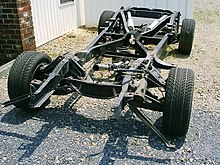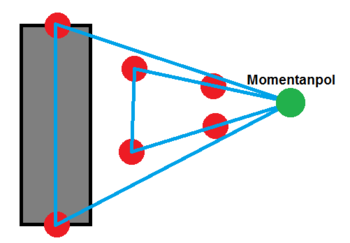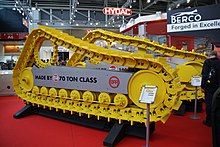landing gear
The chassis is the entirety of all parts of a land or aircraft that connect the chassis to the roadway , rails or taxiway via the wheels or caterpillars . The creeping and walking structures in earthworks and opencast mining have a special position .
Wheel chassis
Road vehicles
In addition to the drive train and the vehicle body, the chassis is a main component of the automobile. It consists of wheels , wheel carriers , wheel bearings , brakes , wheel suspension , subframe , suspension including stabilizer , damping and steering .
The self-supporting body of a car is both the chassis and the majority of the vehicle body.
bikes
The " wheel ", actually the wheel-tire combination, consists of a tire and a rim. The wheel represents the entire body, consisting of the rim and wheel disc (wheel dish) or wheel spider or wheel spokes with hub part . The rim is used to hold the tire. Wheel disc, wheel spider or spokes with hub parts are used for the central attachment of the wheel to the wheel hub. “Complete wheel” is the term for the complete wheel (tire, wheel and valve). In practice, the terms rim and wheel are often confused.
The "wheels" are the contact point between the chassis and the road. You thus have a significant influence on the driving dynamics. They belong to the unsprung masses of the vehicle and should therefore be as light as possible. The changing loads place high demands on the strength of the wheels and the wear and tear on the tires. The tires have to create a slip-free connection to the road in all weathers and different road surfaces. The wheel suspension ensures that the wheels are in contact with the road.
Suspension
The term wheel suspension is used to describe all components for the movable connection between the wheels and the chassis or the self-supporting body. They transmit steering, braking and all acceleration forces. The wheel suspension is attached directly to the frame in a vehicle with a frame construction. So-called subframes are often used on vehicles with a self-supporting body in order to connect the parts of the wheel suspension to the body.
steering
A non-rail vehicle can be steered in a desired direction by the steering device. Each time the steering is turned, the wheels assume a position relative to one another that is determined by the chassis geometry. The steering trapezoid enables different steering angles (toe angles) of the front wheels, whereby the wheel on the inside of the curve is turned more strongly than the outside of the curve.
brake
The chassis has to transfer deceleration forces to the roadway with as little slip as possible. The wheel brake or the service brake is responsible for providing deceleration forces. Service brakes are all components of a brake that, under the direct influence of the driver, serve to reduce the driving speed, to stop safely and to maintain the speed. They are mounted on the chassis and act directly on the wheels. However, special designs can also act on the wheels via a drive shaft.
Chassis parameters
The driving dynamics properties of the wheel suspension depend on the chassis geometry, the mass distribution and the force characteristics. The following, partially variable parameters are decisive:
camber
The camber is the inclination of a wheel, namely the deviation from the vertical position. The deviation is called the camber angle. If the wheel is inclined outwards (as if it were about to fall over) the camber is positive, a wheel inclined inwards has a negative camber.
track
The toe angle is the angle between the longitudinal axis of the vehicle projected onto the roadway and the line of intersection between the wheel center plane and the roadway plane.
Toe-in
The toe-in angle is the toe angle when the steering wheel is in the straight ahead position. The toe-in used to be specified in mm . The distances between the inner rim edges of the wheels of an axle, at the height of the wheel center, were measured at the front and rear and both values were subtracted. If the distance at the front of the wheel is smaller than that at the rear of the wheel, the toe-in is positive. If, on the other hand, it is smaller at the rear than at the front, the toe-in is negative. In this case one speaks of the so-called toe-out . Toe-in is used on the rear axle to improve driving stability. The disadvantage of too large a toe-in can be increased tire wear .
Helical suspension
The helical suspension angle is the angle from the vertical at which the wheel center moves backwards during compression. Through the oblique suspension angle slightly changes wheelbase .
Overrun (overrun route)
The caster or the caster distance is the distance between the track point and the wheel contact point in a view from the side of the wheel.
Roll radius / roll radius
The steering scrub radius is the vertical distance between the point of intersection of the spreading axis (steering axis of rotation) through the roadway and the line of intersection between the wheel center plane and the roadway plane. If the penetration point is further outside than the wheel contact point, the value is negative.
Suspension travel
The distance a wheel travels between the compressed and rebound positions is called the spring deflection. The measurement is perpendicular to the road. The spring deflection between the static spring deflection when the vehicle is empty and when the vehicle is fully deflected is called 'positive spring deflection', and that between the static spring deflection when the vehicle is empty and the fully extended state (vehicle raised) is called the 'negative spring deflection'.
Spring characteristic
The spring characteristic for equal and reciprocal suspension is shown in a diagram of wheel load versus spring travel.
Natural frequency
The number of natural vibrations depends on the spring constant and mass of a resilient system. It is shown in a diagram and should be as constant as possible, that is, it must not change when it is loaded. This can be approximated with a progressive spring characteristic.
Damping capacity
In force-speed diagrams, the damper force is shown as a function of the piston speed.
Momentanpol (momentary center) and roll center
In the case of a double wishbone wheel suspension , the instantaneous pole is, in simplified terms, the point of intersection of the two arm center lines on one side of the axle. If straight lines are drawn from the instantaneous poles of both sides through the wheel contact points, the roll center is obtained . Both change their position when the suspension springs. Both are crucial for driving stability and must be taken into account in the design.
Roll axis
The roll axis is the connecting line between the roll centers of the front and rear axles.
Toe difference angle
The track difference angle is the angle difference by which the wheel on the outside of the curve is turned less than the wheel on the inside of the curve.
Related topics
The single-track model is a simplified model of the lateral dynamics of two-track vehicles with pneumatic tires.
plane

In aircraft landing gear serves for rolling (English: taxi), start and landing as well as for moving the aircraft on the ground (eg. Helicopter ). In the latter case, the aircraft does not necessarily have to be powered by its own engines, but can also be towed or pushed backwards ( pushback ).
On most larger aircraft, the landing gear is retracted (retractable) during take-off after take-off to reduce air resistance . It is only extended again before landing . Since 2009 a ground landing gear has been researched, which should make it possible to operate aircraft without their own landing gear.
Winding machines and construction site equipment
Industrial trucks can be equipped with wheeled trolleys.
Rail chassis

In the case of rail vehicles, the chassis takes over the guidance of the vehicle on the track and transfers the forces that occur. For example, hoisting machines and construction site facilities such as (bridge) cranes have rail trolleys.
Trams usually have a combination of motor bogies or motor bogies at the ends and a running gear or running bogie in the middle of the vehicle.
Crawler tracks
A crawler chassis (also crawler chassis ) usually consists of two crawler tracks , a chassis drive and the chassis frame. If two crawler units are not sufficient, there are multi-crawler units with several crawler units , which are arranged symmetrically or asymmetrically to the longitudinal axis of the machine. Versions are single, paired or doubly paired.
Walker
The walking gear is a special form of the chassis and is mainly used to move construction machinery. It consists of several walking feet that can be moved independently of each other.
Literature and Sources
- Folkmar Kinzer (Ed.): Motor vehicle chassis . 5th edition. Transpress, Publishing House for Transport, Berlin 1987, DNB 871001721
- "Motor vehicle technology"
- Holland + Josenhans-Verlag Stuttgart. 4th edition 2006, ISBN 978-3-7782-3800-4 .
- Verlag Handwerk und Technik. 4th edition 2009, ISBN 978-3-582-03800-5 .
- "Motor vehicle technology" from EUROPA-FACHBUCHREIHE - Verlag Europa-Lehrmittel
- Bernd Heißing, Metin Ersoy, Stefan Gies: Chassis Manual : Basics, Driving Dynamics, Components, Systems, Mechatronics, Perspectives . Vieweg / Springer Vieweg 2007, 2008, 2011, 2013. ATZ / MTZ specialist book.
- Günter Kunze, Helmut Göhring, Klaus Jacob: Conveying technology and construction machinery: Earthworks and opencast mining machines ; 1st edition 2002; ISBN 978-3-663-09352-7 .
Web links
- Drawings for the chassis settings
- Christian Weber: Concepts and basics of automotive engineering, KFZ04 - chassis ( Memento from September 29, 2007 in the Internet Archive ) ( PDF , 3.9 MB). Saarland University, January 23, 2006.
- That's why motorcycle chassis are getting better and better. In: Süddeutsche Zeitung . May 4, 2013, accessed May 4, 2013 .
Individual evidence
- ↑ Bernd Heißing, Metin Ersoy, Stefan Gies: Chassis Manual : Basics · Driving Dynamics · Components · Systems · Mechatronics · Perspectives (ATZ / MTZ book) . 4th edition. Springer Vieweg, 2013, ISBN 978-3-8348-0105-0 , p. 1 .
- ^ A b Karl-Heinrich Grote, Jörg Feldhusen: Dubbel: Paperback for mechanical engineering . Springer-Verlag, 2011, ISBN 978-3-642-17306-6 , pp. U 3 ( google.de [accessed on April 21, 2019]).
- ↑ Martin Scheffler, Klaus Feyrer, Karl Matthias: Carriers: hoists, elevators, industrial trucks . Springer-Verlag, 2013, ISBN 978-3-663-16318-3 , pp. 91 ff . ( google.de [accessed on April 21, 2019]).
- ^ Günter Kunze, Helmut Göhring, Klaus Jacob: Construction machinery: Earthworks and opencast mining machines . Springer-Verlag, 2013, ISBN 978-3-663-09352-7 , pp. 114, 121, 129, 130 ( google.de [accessed April 20, 2019]).
- ↑ Table of contents (pdf), foreword (pdf), excerpt (7 MB, 119 pp.)




